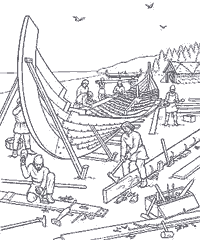The Shipyard:
Most shipyards on Hârn consist of a warehouse for storing valuable items like iron, pitch, and sailcloth to name a few. The warehouse is usually
under guard at night and acts as a workshed in the day.
Some activities that can be undertaken in the warehouse are:
-
Ropemaking - At a minimum rope is made in lengths of 100 feet or more. Most of the time ropemaking is an outside activity in good weather.
Since the shipwright's guild does not have the monopoly in this area, most rope is acquired from outside sources.
-
Sailmaking - One section of the warehouse may also be set aside as a sail loft. In this facility a senior journeyman oversees the
construction and repair of sails. If such a facility is not available a yard may have to contract with a local tentmaker's guild for sails.
In addition to the warehouse there is usually another structure housing the shipwright's offices and residence. The yard itself will be holding a large
supply of timber, straight and bent. This supply will also be under guard since good firewood is at a premium in most Hârnic cities. In addition to this
facilities, some yards will also boast a tidal dry-dock or slipway of some kind. However, most vessels needing repairs will need to be beached on a gently
sloping bank; therefore, most of the actual work on vessels will be conducted in other suitable sites that can be accessed by water. Towards this end, many
shipyards will also maintain a small fleet of utility vessels for transporting men, equipment and supplies.
The Worksite
|

|
Since a vessel needs a gently sloping bank in order to beach it, most of these sites will be located outside of a city's limits. Vessels
needing repair will be beached at high-tide, as the tide lowers supports will be added to the sides to keep the vessel erect. However, if
the hull needs repair the vessel must be careened. To do this it must brought into the bank sideways. Ropes are then attached to the mast
and the vessel is pulled over onto it's side. Worksites like this are usually guarded by the vessel's crew unless other arrangements have
been made. Each day men, supplies and equipment are ferried to each worksite. In addition to beaching, slipways may also be dug into the
bank to allow a vessel to be brought into it at high-tide and a retaining wall to be build at low tide so the vessel can be worked on in a
temporary dry-dock facility.
|
|